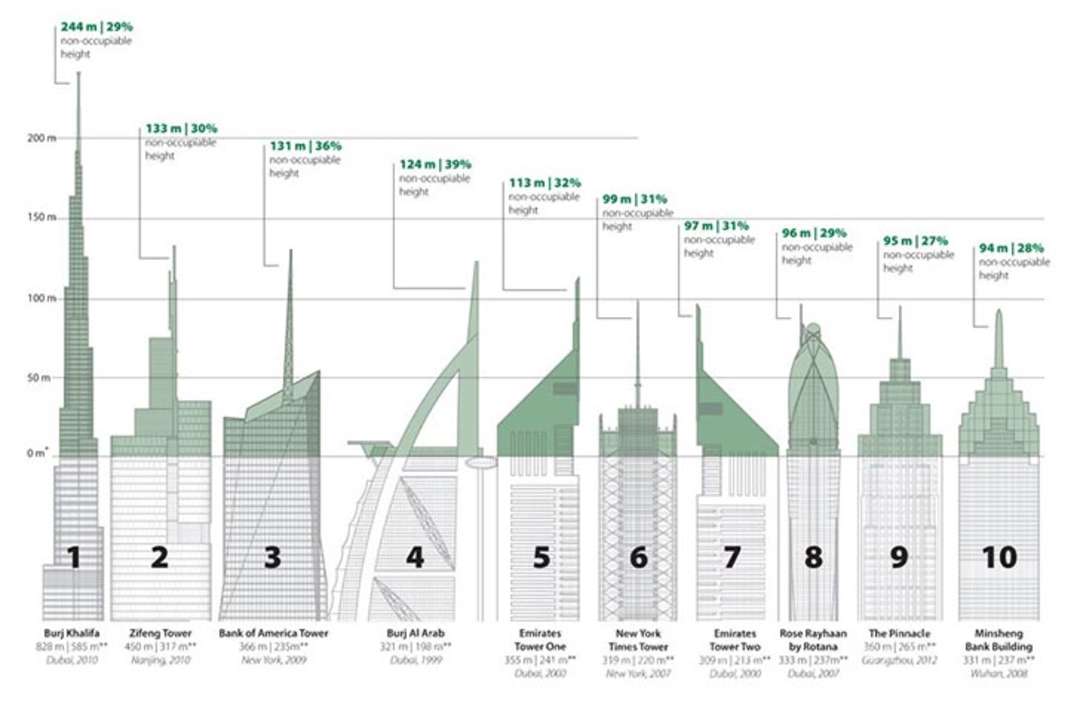It is known among tall-building architects that there are many tricks to increase the height of skyscrapers. But inflated skyscraper height came to the attention of the Council on Tall Buildings and Urban Habitat (CTBUH) last year after a case study suggested that the Kingdom Tower was designed with large decorative "vanity space" on top, inside of its spire, to enhance its height. Kingdom Tower, designed by Adrian Smith + Gordon Gill, is set to be the tallest tower in the world when built.
As a result, CTBUH performed a study which illustrates that large portions of some skyscrapers are actually useless space used to artificially enhance their height, Architizer reports. CTBUH created an infographic showcasing the vanity space phenomenon. Vanity space is defined as the distance between a skyscraper's highest occupiable floor and its architectural top.
Burj Khalifa, currently the tallest building on the globe, at 2,716 feet, has an 800-foot-tall unoccupied spire that accounts for nearly a third of its overall height. Ukraina Hotel in Moscow gets the award for having the largest percentage of vanity space: 42% of its 675 feet is unoccupied space.
See the infographic below, and you can read the full report here.
Courtesy of CBTUH
Related Stories
| Dec 16, 2011
Goody Clancy-designed Informatics Building dedicated at Northern Kentucky University
The sustainable building solution, built for approximately $255-sf, features innovative materials and intelligent building systems that align with the mission of integration and collaboration.
| Dec 16, 2011
Stalco Construction converts Babylon, N.Y. Town Hall into history museum
The project converted the landmark structure listed on the National Register of Historic Places into the Town of Babylon History Museum at Old Town Hall.
| Dec 14, 2011
Belfer Research Building tops out in New York
Hundreds of construction trades people celebrate reaching the top of concrete structure for facility that will accelerate treatments and cures at world-renowned institution.
| Dec 14, 2011
Tyler Junior College and Sika Sarnafil team up to save energy
Tyler Junior College wanted a roofing system that wouldn’t need any attention for a long time.
| Dec 13, 2011
Lutron’s Commercial Experience Center awarded LEED Gold
LEED certification of the Lutron facility was based on a number of green design and construction features that positively impact the project itself and the broader community. These features include: optimization of energy performance through the use of lighting power, lighting controls and HVAC, plus the use of daylight.
| Dec 12, 2011
AIA Chicago announces Skidmore, Owings & Merrill as 2011 Firm of the Year
SOM has been a leader in the research and development of specialized technologies, new processes and innovative ideas, many of which have had a palpable and lasting impact on the design profession and the physical environment.
| Dec 12, 2011
Skanska to expand and renovate hospital in Georgia for $103 Million
The expansion includes a four-story, 17,500 square meters clinical services building and a five-story, 15,700 square meters, medical office building. Skanska will also renovate the main hospital.
| Dec 12, 2011
CRSI design awards deadline extended to December 31
The final deadline is extended until December 31st, with judging shortly thereafter at the World of Concrete.
















